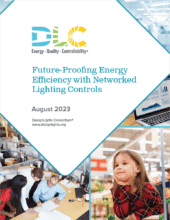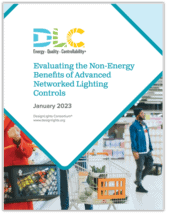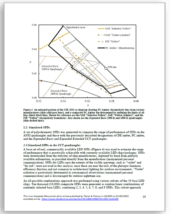This website uses cookies so that we can provide you with the best user experience possible. Cookie information is stored in your browser and performs functions such as recognising you when you return to our website and helping our team to understand which sections of the website you find most interesting and useful.
Industry Reports and Research

Executive Summary: Choosing Both Energy Efficiency and Light Pollution Mitigation for Commercial Outdoor Lighting
There is a perception that, in a commercial retrofit setting, light pollution mitigating LEDs are less efficient and more costly than energy efficient LEDs, but in some cases you can have the best of both worlds. The DLC commissioned a study to research the impacts of LED applications that are both energy efficient and minimize light pollution as compared with products focused solely on energy efficiency. This executive summary provides an overview of the results of the research.
Key Takeaways
- An overview of how utilities can help municipalities achieve their energy efficiency and decarbonization targets while protecting ecosystems and preserving the night sky for future generations.

Choosing Both Energy Efficiency and Light Pollution Mitigation for Commercial Outdoor Lighting
There is a perception that, in a commercial retrofit setting, light pollution mitigating LEDs are less efficient and more costly than energy efficient LEDs, but in some cases you can have the best of both worlds. The DLC commissioned a study to research the impacts of LED applications that are both energy efficient and minimize light pollution as compared with products focused solely on energy efficiency. The study includes analysis of the impact on ROI, annual energy use, and energy costs.
Key Takeaways
- Learn how utilities can help municipalities achieve their energy efficiency and decarbonization targets while protecting ecosystems and preserving the night sky for future generations.
- Discover how municipalities can meet their energy goals while reducing the harm caused by excessive outdoor lighting.
- Learn new ways to calculate ROI for responsible outdoor lighting.

Future-Proofing Energy Efficiency with Networked Lighting Controls
This is a summary of the potential study commissioned by the DLC titled "Economic Potential of Networked Lighting Controls in Commercial Buildings: Tapping the Added Value of HVAC Connections."
Key Takeaways
- Learn how integrating HVAC and NLC systems can enhance energy efficiency, increase ratepayer savings, and lower carbon emissions.
- Action items for regulators and energy efficiency programs based on the new data.

Evaluating the Non-Energy Benefits of Advanced Networked Lighting Controls
This resource, which summarizes research commissioned by the DLC and conducted by Skumatz Economic Research Associates, Inc. (SERA), identifies non-energy benefits (NEBs) specific to NLC usage and develops a methodology for assigning them quantitative values.
Key Takeaways
- “Non-energy benefits” of NLCs can enable inclusion of anticipated savings from productivity gains, safety and security enhancements, extended equipment lifecycles, and more in cost-benefit calculations.
- Developing a methodology for assigning quantitative values to NEBs will enable utility incentive program staff and others to use an expanded set of metrics for measuring the cost-effectiveness of NLC implementation.
- Research showed statistically significant non-energy benefits from NLCs for both lighting decision makers and building occupants.

Journal Article: Specifying non-white light sources in outdoor applications to reduce light pollution
This journal article, originally published in Leukos on January 5, 2023, proposes a specification structure for amber light sources to increase the precision of language used in the industry, and encourages lighting standards development organizations to consider standardizing such a system. It also demonstrates that non-white light sources with well-defined chromaticity ranges outside of the ANSI C78.377-2017 quadrangles may be useful for reducing wasted light that causes sky glow, a phenomenon that is associated with approximately $7 billion in wasted energy and nearly 66 million metric tons of CO2 emissions annually.
Key Takeaways
- A call for the lighting industry to consider developing industry consensus definitions and standards for “amber" light sources.
- Methodology for expanding ANSI standard CCT chromaticity bins to include three new bins: 1800K, 2000K, and PC Amber.
- Discussion of why CCT alone is not an adequate representation of the spectral composition of light, and the wide range of potential impacts to sky glow.

Outdoor Lighting Ordinances
The DLC conducted research to identify locations with published outdoor lighting ordinances to mitigate light pollution. Check the map to see if you have an outdoor lighting ordinance in your area.
Key Takeaways
- Learn more about what an outdoor lighting ordinance is
- Check the map to see if you have an outdoor lighting ordinance in your area
Still need help?
© 2023 DesignLights Consortium. The DesignLights Consortium is a project of Efficiency Forward, Inc., a non-profit 501(c)3 organization. Privacy Policy Terms of Use


